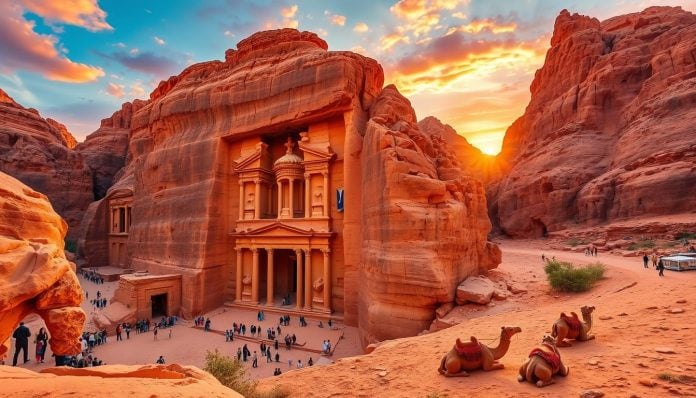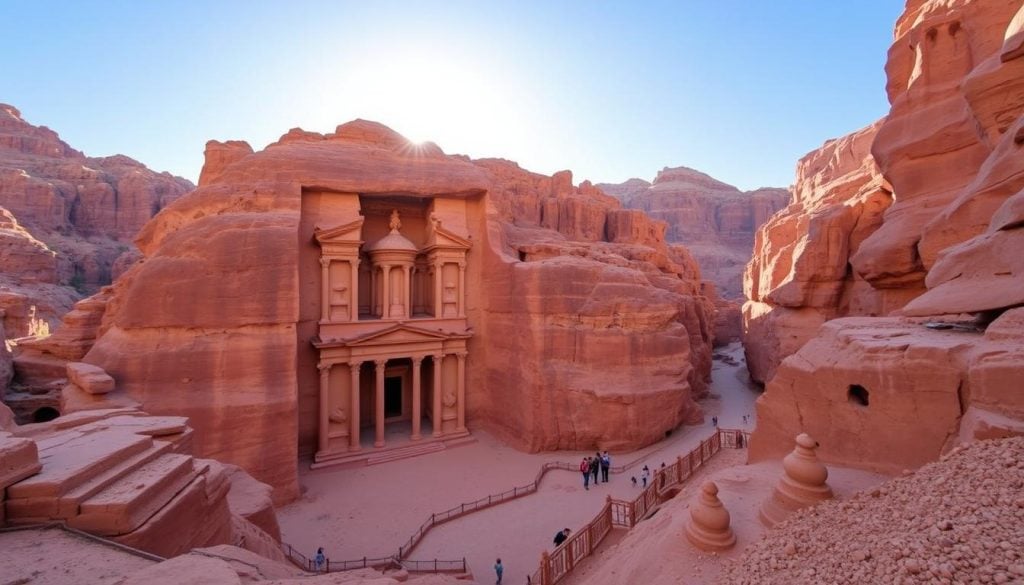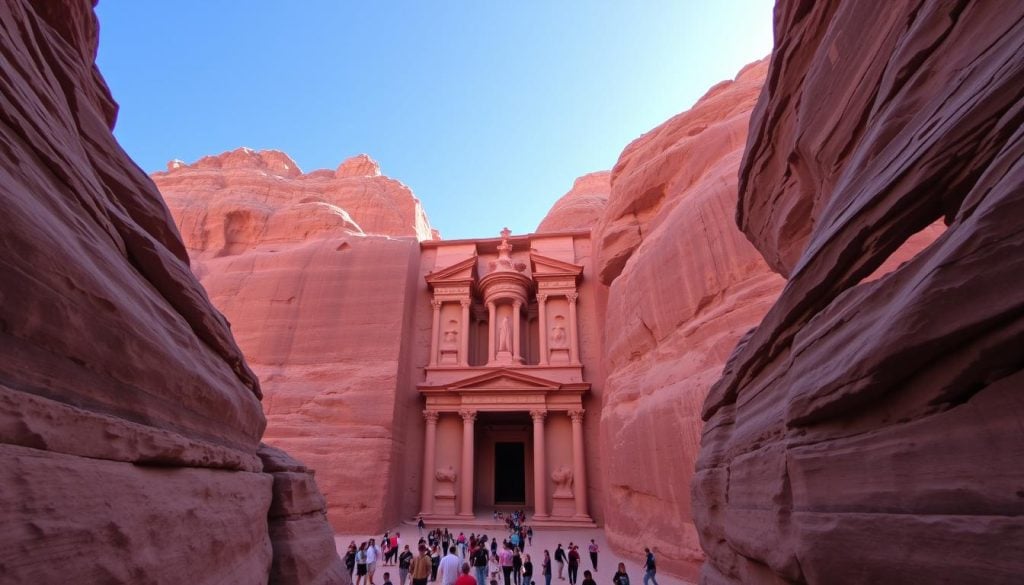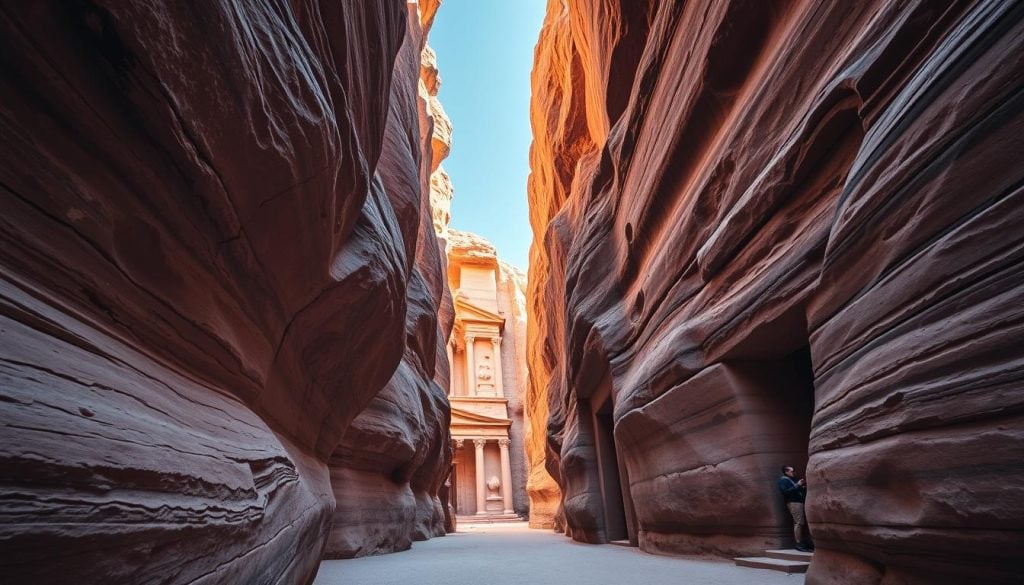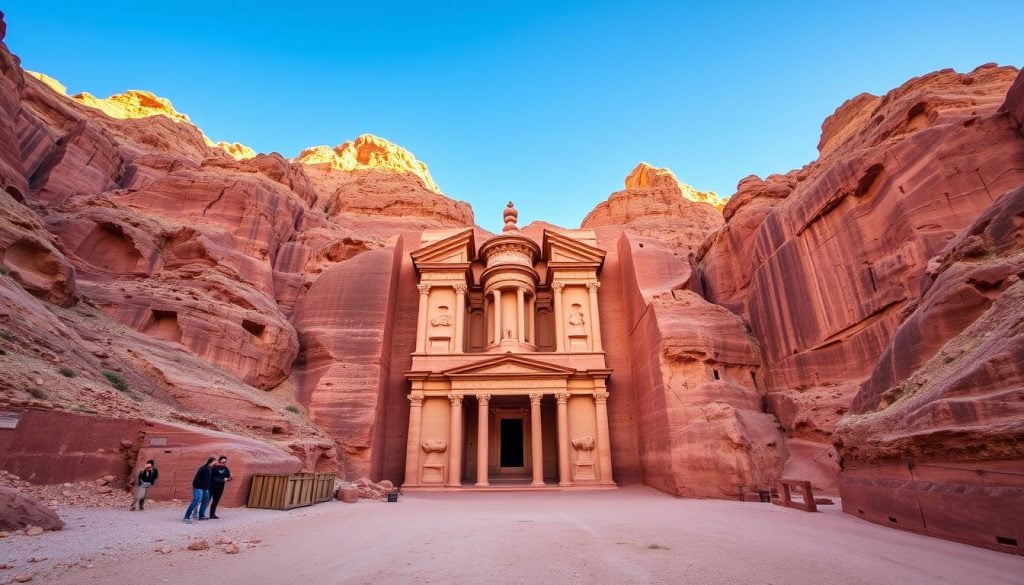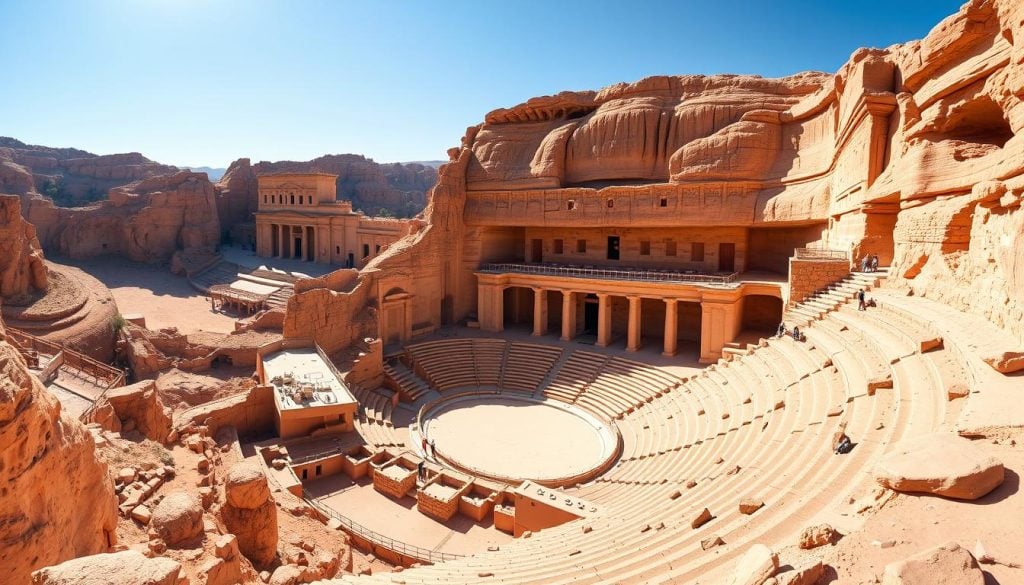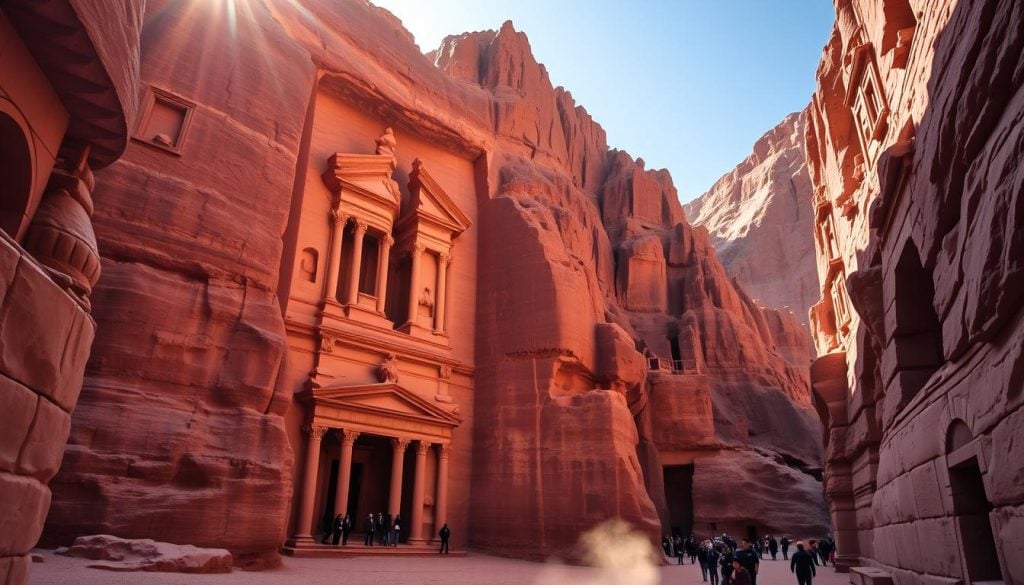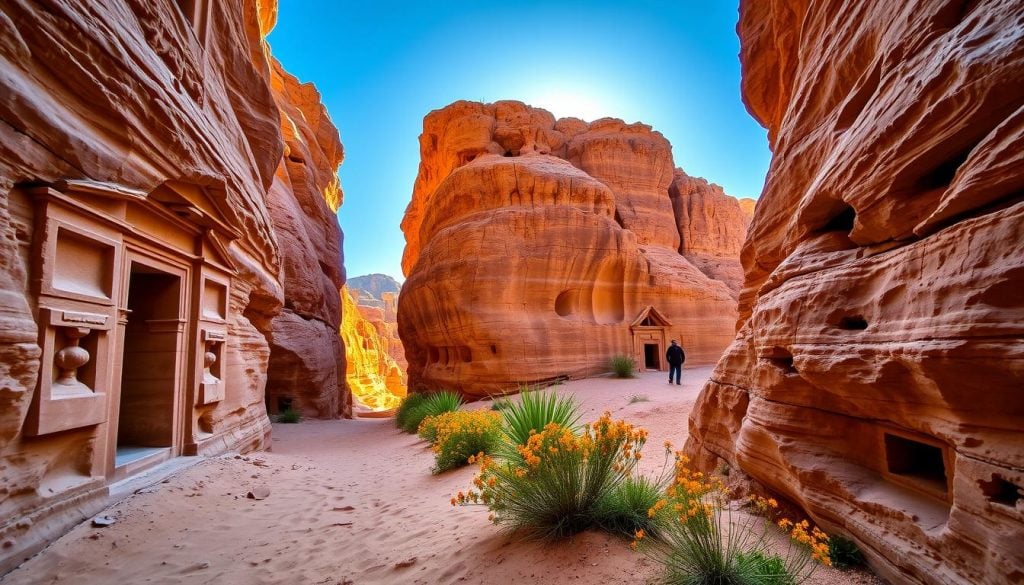Have you ever wondered about the secrets beneath Petra’s sands? It’s one of the world’s most famous archaeological sites. Only 15% of its wonders have been unearthed. The mystery of this ancient Jordan city still captures hearts. Our guide reveals the top 10 must-see spots in Petra. Get ready for historic sites, local tales, and stunning views. All these make Petra a UNESCO World Heritage site.
Start your Petra journey with excitement. Be amazed by the Nabataeans’ incredible feats. Each part of this old city has its unique story. Our guide highlights the can’t-miss experiences. From the majestic Siq walk to the iconic Treasury view, your trip will be memorable.
Introduction to Petra: A Jewel of Jordan
As you approach Petra, the “Rose City,” the red sandstone cliffs catch your eye. Its unique rock-cut architecture makes it stand out. Recognized as a UNESCO World Heritage site in 1985, Petra is also one of the Seven Wonders of the Modern World. It was once a bustling Nabataean trade center until an earthquake in 363 AD changed its fate.
Only 15% of Petra has been uncovered. The rest remains a mystery under the sand. Petra beckons travelers with sights like the Siq, the Treasury, the Royal Tombs, and the Monastery. A visit can range from one to three days. Two days offer a relaxed pace, three days allow for thorough exploration of hidden spots.
Petra is a top destination with its breathtaking architecture and deep history. The best times to visit are spring and fall, avoiding extreme heat or cold. Entry fees are $70 for one day and $77 for two. Petra promises a journey back in time.
Top 10 Things to Do in Petra
Exploring Petra means stepping into history, where you see its rich past and lively culture. This ancient city is carved into rose-red rock. It shows off marvels for those ready to uncover its stories. Your Petra travel guide will highlight attractions showcasing Nabataean artistry. You’ll see their architectural skills and clever water systems.
Overview of Petra’s Historical Significance
Petra was a crucial trade center, linking major routes across the Mediterranean, Red Sea, and Persian Gulf. Founded by the Nabataeans around 100 BC, it became a bustling spot for merchants. Today, the rock carvings and buildings show influences from Egyptian, Greco-Roman, and Nabataean cultures. This makes Petra sightseeing intriguing, filled with ancient tales.
The UNESCO World Heritage Status
Since December 6th, 1985, Petra has been a UNESCO World Heritage site. It’s one of the New Seven Wonders of the World. Millions visit each year to see its stunning structures and landscapes. Sites like the Treasury and the Monastery blend natural and human-made beauty. A good Petra travel guide helps you appreciate these wonders, letting you fully enjoy the Top 10 Things to Do in Petra.
Explore the Majestic Siq: Entrance to Petra
The Siq is the dramatic door to Petra, stretching 1.2 kilometers. Tall sandstone walls, up to 80 meters high, flank it. This gorge wows visitors with stunning geology and deep history. Walking through, you’ll see ancient carvings and old water channels. They show the Nabataeans’ smart engineering from long ago.
Understanding the Geology and History of Siq
The Siq is more than a path. It’s a mix of nature’s power and human effort. The gorge has amazing rock formations, shaped over thousands of years. It’s a key site in Petra, Jordan. This path was vital for reaching Petra, used first by Nabataeans, then Romans and nomads.
What to Look Out for Along the Route
While walking the Siq, look for these:
- Ancient Carvings: See the detailed carvings, showing Nabataean skills.
- Water Channels: Note the old water systems, crucial for life in dry areas.
- The Grand Reveal: Get ready for the amazing sight of the Treasury at the journey’s end.
Seeing the Siq makes your Petra trip richer. It connects you to Petra’s special past and geology. The Siq’s magic start points to more wonders ahead.
The Iconic Treasury: Al-Khazneh
The Treasury, known as Al-Khazneh, stands as a highlight of Petra’s historical sites. Its grand entrance is truly captivating. The building rises about 40 meters high, showing off its detailed facade. This includes Corinthian columns and stunning carvings. Many think it was a mausoleum, which adds to its historic value.
Although entry is off-limits, there are spots nearby perfect for Petra sightseeing. You can take stunning photos from these points.
Architectural Features and Design
Al-Khazneh’s front side is rich with decorations that show the Nabateans’ art skills. They mixed styles from different cultures. Key features are:
- Corinthian Columns: These reflect Greek influence and support the structure’s upper parts.
- Intricate Carvings: These carvings depict mythological scenes, offering a glimpse into Nabatean culture.
- Substantial Scale: Its size makes it a top destination in Petra.
Interesting Legends Surrounding the Treasury
Many legends add mystery to Al-Khazneh. Some say it was named “The Treasury” because it held hidden treasures. These stories have fascinated people for years. Some believe thieves hid their gold here. Others think pharaohs kept their wealth in it during their campaigns.
Such tales make this monument even more intriguing. Visitors love exploring its history.
The Stunning Monastery: Ad Deir
Visiting the Monastery, known as Ad Deir, is a top moment in your Petra journey. This site is bigger than the Treasury, with a façade that reaches 45 meters. To see this wonder, you must hike for about 1.5 hours over 850 steps.
Along the way, the views of Jordan’s landscape are stunning. When you arrive, the vistas and the achievement feel rewarding.
Hiking Trails to the Monastery
Your climb to the Monastery is tough but thrilling. It’s a 20-minute steep hike. You can hire a donkey for ease, starting at 10 dinars, but possibly only paying three.
Local sellers line the path, offering trinkets that add to the charm.
What to Expect Inside the Monastery
Inside, you find large chambers that share the Monastery’s past. It has been both a temple and a church. Its design is purely Nabataean, simple yet strong.
This uniqueness makes the Monastery stand out in Petra. A visit of at least 24 hours is suggested to fully enjoy Petra, including this magnificent site.
Uncover the Royal Tombs
Seeing the Royal Tombs is a key part of visiting Petra. These tombs show the Nabataeans’ skill in architecture. Each tomb has its own special features that share tales of ancient royal funeral traditions. Walking through these sites, you’ll see the detailed work that reveals the social status of the people laid to rest.
Exploring Different Tomb Features
The Royal Tombs have well-kept buildings like the Urn Tomb, the Silk Tomb, and the Palace Tomb. They give us a look into different building styles and old burial ways.
- Urn Tomb: Features a grand facade, serving as a monumental entrance to the royal resting place.
- Silk Tomb: Known for its colorful rock layers resembling silk fabric, offering visitors a visual treat.
- Palace Tomb: Captivating with its elaborate details and spacious design, hinting at the grandeur of Nabataean royalty.
Visiting During Sunset for a Magical Experience
Going to the Royal Tombs at sunset makes it magical. The sunset turns the stone colors warm, highlighting the beauty. Visit then for amazing photos and a quiet time as fewer people are around.
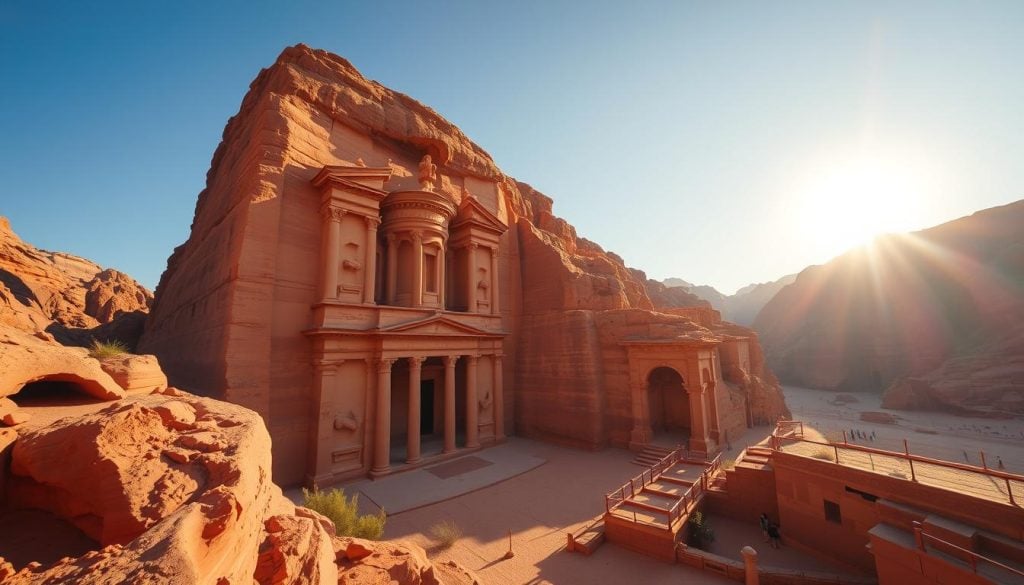
To enjoy quiet moments, come early in the day. Morning visits are peaceful, allowing a closer look at these stunning tombs. The play of light and shadow here will stay with you forever.
| Tomb Name | Notable Features | Visitor Experience |
|---|---|---|
| Urn Tomb | Grand facade | Impressive entrance |
| Silk Tomb | Colorful rock layers | Visual feast |
| Palace Tomb | Elaborate details | Sense of grandeur |
Historic Roman Theater: A Cultural Epicenter
The Roman Theater is a grand example of Nabataean architecture with Roman touches. Built in the 1st century AD, it shows how cultures merged in Petra. Originally, it held 3,000 people but later expanded to fit over 8,000. This change highlights its key role among Petra Jordan attractions. It was where the community’s lively culture was on full display.
Architecture and Capacity of the Theater
This theater was carved out of rock, showing incredible ancient skill. It was designed so everyone could hear clearly, thanks to its tiered seating. With Roman-style corridors and seating, it was more than an entertainment spot. It also brought the people of Petra together, building a strong sense of community.
Journey Along the Street of Facades
Exploring the Street of Facades is a key part of visiting Petra. This pathway is surrounded by beautiful tombs and monuments. They show the skill of ancient Nabataean builders. As you walk, you’ll see the Roman Theater and the Great Temple. Tours of Petra help you understand and enjoy these places more.
Key Structures Located Along the Street
As you walk along the Street of Facades, you’ll see many important sites:
- The detailed tombs, each with its own story.
- The Great Temple, a place with lots of archaeological interest.
- The Roman Theater, where Nabataean and Roman styles mix.
- The Petra Museum, with artifacts and exhibits about this ancient city.
Souvenir Shopping and Local Experiences
While traveling the Street of Facades, explore local shops. You’ll find unique crafts and souvenirs. Buying from local vendors helps small businesses and gives you a taste of the culture. Popular items include:
- Handmade jewelry and pottery.
- Traditional Bedouin fabrics and textiles.
- Artisan soaps and local foods.
Experiencing local culture, like Bedouin tea ceremonies or performances, enriches your visit. The Street of Facades offers education, adventure, and culture. It’s a chance to engage with local traditions while appreciating Petra’s beauty. Don’t miss out on connecting with the culture and exploring this historic place.
Discover Little Petra: Siq Al-Barid
Little Petra, also known as Siq Al-Barid, is just nine kilometers from Wadi Musa. It acts as a fascinating introduction to Petra’s main ancient city. This hidden treasure has an array of rock-cut buildings from the 1st century AD. It gives a unique look into Nabataean culture.
The Significance of Little Petra in Nabataean Culture
In your Petra travel guide, Little Petra stands out with its Petra Jordan attractions that show Nabataean daily life. The 350-meter long Siq al-Barid features carved houses, temples, and triclinia. A must-see is the Painted House with its rare Nabataean frescoes, showcasing a winged cupid and Pan playing a flute.
A trip to Little Petra usually takes about 1.5 hours, offering a deep dive. It’s a key part of the bigger archaeological site. Plus, it has a trail to the Monastery for those up for a 1.5 to 2-hour hike.
Visiting Little Petra costs nothing, and it’s open every day from 6 am to 6 pm. This makes planning easier. Though not needed for Little Petra, getting a Jordan Pass for Petra is smart. Local Bedouin guides offer tours for 20 JD, adding valuable cultural stories.
Conclusion
A trip to Petra is like traveling back in time. It shows historical and cultural depths that are rare to find. When you walk through this old city, the amazing buildings catch your eye. Sites like the Monastery and the Royal Tombs show how clever the Nabataean people were. This Petra travel guide lists the top 10 things to see, ensuring you catch all the stunning views.
Walking through the Siq or hiking up to The High Place of Sacrifice feels like an adventure. Petra was home to 20,000 to 30,000 people at its peak. It mixes history with the excitement of exploring. Climbing to places like the Monastery or the Great Temple is more than exercise. It’s a chance to see Petra’s beauty up close.
This guide helps you find the best spots in Petra, from the grand entrance at the Siq to peaceful Little Petra. Make sure to plan your visit well. This way, you can enjoy every bit, whether you’re going up high or exploring old paths. Take this opportunity to make unforgettable memories at this wonderful UNESCO World Heritage Site. Let your Petra journey be filled with awe and surprise.

































